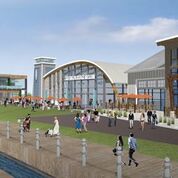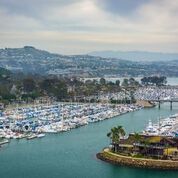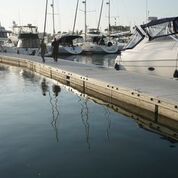Joe Ueberroth Discusses Marina Development and Industry Trends
Published on April 6, 2020Editor’s Note: Marina Dock Age magazine talked with Joe Ueberroth, owner and CEO of Bellingham Marine. Ueberroth’s investment firm Bellwether is also part owner of Dana Point Harbor Partners, the partnership that is redeveloping Dana Point Harbor in California. In the late 1990s, Ueberroth’s marina management company, BellPort Group, partnered with Nishida Tekko, the owner of Bellingham Marine, to develop and operate marinas in Japan. In 2006, Ueberroth bought Bellingham, through a public company that he was operating at that time. In 2009, his company Bellwether, bought all the Bellingham assets and privatized the company. Ueberroth has an extensive background in investments in a wide range of industries and businesses – from internet companies to hotels, greenhouses and riverboats. As an owner and entrepreneur, he has repeatedly learned, sometimes the hard way, that fundamentals in business do matter. His successes and failures have influenced his business strategy as a dock builder, marine contractor and marina developer. We talked with him about development trends for marinas, aggregation of the industry, the waterfront lifestyle and what all that means for his marina businesses.
Q: How would you describe your experience working internationally and how does that compare to U.S markets?
Ueberroth: The place I’ve had the most international experience is Japan, and in Japan, I quickly realized that there was so much lost in translation. I don’t speak Japanese. I didn’t understand their business environment and what’s important to them. Having great Japanese partners made all the difference.
Most often, the first thing we want to talk about in the U.S. is price. When you meet with a client about a project in Japan, they will say yes to your price for they want to focus on all aspects of quality. When I came to understand from my local partners that price was to be re-negotiated after all other aspects were completed, it removed the frustration from the negotiations.
My experience in Japan influenced how we have expanded Bellingham’s business internationally. We have a couple of plants that we own internationally, but they are all in English speaking countries. In countries where we don’t speak the language, we won’t understand their business. In places, like Korea, China, Japan, Dubai and Spain, we have a local partner.
Q: What does Wall Street think of the marina business?
Ueberroth: My background started with investing funds for General Electric Pension Trust. I’m very comfortable with the big institutions. Although I am now focused on deploying my own capital, I did deploy institutional capital for decades. I’ve had many successes, and I’ve had some failures. I understand that industry pretty well.
At this time, institutional capital is very interested in the marina business. It is a good story, and they’re all looking for yield. Right now, with interest rates so low and everybody so aggressive in Class A type real estate, they’re looking for alternatives. And the marina business looks really fun.
Q: What does Wall Street need to learn about marinas as investments?
Ueberroth: They are making assumptions based on their experience in related real estate investments without fully understanding the specifics of the marina business. It is like applying hotel fundamentals to the cruise business. There are many similarities, but you will be ignoring that one operates in the water. That’s a very different component. People say that marinas are just parking lots for boats. That’s not the case. At Bellingham, we are often asked what the square foot cost is to build a dock. That question assumes that all marinas have the same design loads, wave and wind criteria. In actuality, the square foot cost of docks varies tremendously due to specific site conditions. This is just one small example. I don’t think Wall Street really understands how different one marina can be from another. With that said, everyone I talk to thinks marinas are a great investment opportunity, so I believe we will see more institutional money investing in our industry.
Q: How do you think the aggregation in our industry will inevitably lead to segmentation?
Ueberroth: Our problem is that we’re a small industry. When you’re talking about institutional investors, they need to deploy a lot of capital. They also want to do it quickly. That becomes problematic. To deploy a lot of capital in the marina industry you have to buy a lot of facilities, and they’re not all the same. That’s where I find the challenge. You have to be really good at many different things.
Operating a shipyard in New York is very different from operating a houseboat facility on a lake in Arizona. The challenges that affect marinas in the North East are extremely different from San Diego. To get to their target size, they have to be really diversified. I think over time, they will acknowledge the diversity and distinct requirements of their portfolio and choose to segment into categories such as shipyards, lake facilities, coastal facilities and such. But right now, I believe that there will be so much capital given to the aggregators that the management teams will have to continue to just execute.
Q: How can big capital investment be difficult in an industry like ours?
Ueberroth: As we discussed, when you have to deploy a significant amount of capital quickly, you have to look at many different types of marina facilities. In contrast, the financial parameters for institutional capital are usually singular and rigid. An additional difficulty is that their models don’t contemplate inadequate reserves, mistakes or unforeseen challenges. As time goes by and you face challenges, it has been my experience that the decision process becomes more influenced by the financial parameters than what is actually the best decision for the business.
At least for me in my previous experience with institutional capital, there has been a lot of emphasis on near-term cash flow and returns to the investors that competed with capital expenditures, R&D, and investing in talent. It was always extremely difficult when the financial requirements of the capital did not align with the financial requirements of the business. The immediate reaction is to hope that with size this misalignment can be corrected. However, history has shown us that it doesn’t in most cases. In a couple of my previous investments, I made some mistakes because of this dynamic.
Q: What’s important to understand about development big picture?
Ueberroth: This is my own philosophy. If you’re going to develop a marina, you should look at the total available market. The marina isn’t just your slip tenants. We look at it as waterfront activation and try to take into account everybody that you want to touch your facility. When you think about the non-boat owner as part of the business, the marina becomes a much bigger and more dynamic concept. We think marina operators are better off viewing marinas as waterfront destinations instead of parking lots for boats.
Q: As an operator, where have you seen issues with marina development and long-term leases?
Ueberroth: Marina del Rey, the largest manmade pleasure boat harbor in the U.S., was a great example of what can go wrong with marina development and long-term leases. The harbor was created approximately 60 years ago, and multiple developers received 50-year leases throughout the harbor. Over time it became apparent that the marinas that were built weren’t going to last the length of the lease. With only 10 years left on the lease, operators had no incentive or frankly reserves, to invest in their facilities, even though some were at the stage of being condemned.
So now, the next go around, the county and operators knew they needed to build marinas that would last the length of the lease. That’s a big change.
Most people in our industry interchange development and redevelopment. It is extremely similar with one important difference. From an operator’s standpoint, a long-term lease in a brand new harbor is a very different financial proposition than the same lease with aged seawalls and infrastructure. If we are going to take on that liability, it’s a real liability and you need to negotiate down the rent as appropriate.
Q: How much did Dana Point Harbor Partners negotiate with the county for

the lease at Dana Point and what was most important for both sides?
Ueberroth: For the percentage rent for the marina, we started at 20 percent with the county being responsible for maintenance of the harbor, specifically seawall maintenance and dredging. In the end, we ended up with a percentage rent of 11 percent and us assuming the maintenance and dredging responsibilities. As an operator, you can’t afford to accept previous market rates and ignore aging infrastructure; it’s something you really need to think about. The other major issue for the county was that the marina have adequate reserves. In retail and hotels, having standard reserves was automatic, but as I discussed earlier, reserves have been ignored as it relates to marinas. Their concern was very justifiable considering that we were entering into a 66-year lease and the longevity of current concrete systems are 40 to 50 years while timber, steel and aluminum systems are significantly less. The potential reserves were daunting to say the least. Adding reserves dramatically changes the financial return of a marina. I was in a unique position to address the issue by providing a dock system that has a lifespan that exceeds the term of the lease. The lifespan of a concrete dock system is limited due to the components utilized in the float construction that will corrode and deteriorate. Our dock system for Dana Point will not use steel rods or steel reinforcing within our floats. As a result of our decision to invest in docks with very long service life, we have no reserves as it relates to the marina in our lease with the county.
Q: What are the new plans for Dana Point?
Ueberroth: We took over the lease at end of 2018. We’ve operated a little over a year. The county had spent 20 years trying to get this redeveloped. I’ve worked really closely with the community. There are many numbers in the local coastal plan that we had to hit in terms of number and size of slips, parking facilities and the like. With the limited real estate and water, it was really hard to accomplish. My team worked with the Dana Point boaters’ association and other stakeholders. Together after dozens of renditions, we developed a plan that has strong community support.

The new harbor is much more than just a marina. I have a great retail partner in Burnham Ward, and RD Olson is also best in class in hotel development. Working together, we will revitalize the harbor and activate the waterfront for Orange County and beyond.
In California, we have many marinas that do not talk to the landside. At Dana Point everything will interact. I think we’re going surprise people when you’re looking at how we’re making things accessible.
The other thing I would add is, we’re really thinking about what it should be and not just what it is today. How can we use technology? What will boating look like in 20 years? How do we build a facility for the future?
Q: When do you start construction and how long will it take?
Ueberroth: Hopefully, we’ll start building in 2021. We’re in the entitlement phase now. Once we start building the marina, we’ll build continuously. We’ll do it in phases to keep boaters in the harbor, but we’re not going to start and stop. This year, retail construction commences while the hotels will follow in the next couple of years. We have a 66-year lease, and we plan to be done with the full development in the next six years.
Q: What does all this mean for the Bellingham Marine?
Ueberroth: At Bellingham, for us to be good at our job, we have to really understand and cater to our industry. We have to be a good partner. We’re often dealing with developers that have never done a marina before. We will continue to be successful if we can help the developer, the aggregator, and the individual marina owner achieve their goals. Although the company was founded more than 60 years ago, we never stop innovating.
As we discussed, the new lease length in California is up to 66 years, so we have been investing and testing innovations that extend the lifespan of our product to meet the market.
Most of the great natural sites have been developed. Now we’re looking at places and thinking how do I build a marina in this environment? We will never stop innovating, figuring out how to build a better and longer lasting product. Our capabilities are so much greater today than what we could do 10 years ago. Although it has taken significant R&D, we are leap frogging the industry when it comes to wave attenuators for example.
For me, I really enjoy the R&D aspect of what we do. I don’t think there are many companies that build concrete floats and break them; we kind of like to do that. Engineering has a seat in the C-Suite at Bellingham Marine. Aesthetics are also essential, but aesthetics that last the test of time is what we are shooting for.
On the East Coast, we are building two new state of the art facilities so that we can build more efficiently and effectively in order to meet the ever increasing demand and continue to bring value to our customers.

Some customers don’t want wood walers, so now they are buying our Fiber Reinforced Polymer (FRP) waler. After nine years of R&D, we invented a FRP thru-rod. The new rod resists corrosion and significantly reduces maintenance requirements associated with steel rods, while extending the life of the system.
By extending the life of a marina by 30 years, and it only costs five percent more, think of the value that has been delivered to an owner. It is a huge advantage for all our customers. Not having reserves at Dana Point increased my annual cash flow by millions of dollars.
The impact that the redevelopment of Dana Point has on Bellingham Marine is tremendous. Being the largest coastal marina in the United States, it will be the largest project in our 60 year history. Another great benefit of the size of the project is that it provides our industry partners the justification to invest in innovation within their own companies. All of us are also investing our time and money to maximize the outcome of our combined product. Our combined goal is to build the best marina system possible.
For me personally, I am often asked, no matter what country I am in, what would you build if you were building a marina for yourself? Soon, Dana Point will offer me the opportunity to say come to my office, let’s take a short drive and I will show you.
| Categories | |
| Tags |





